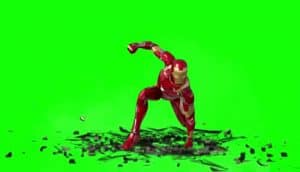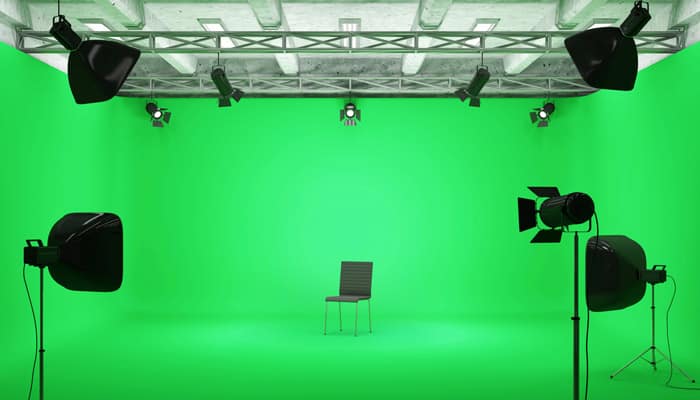How to Light Green Screen for Video?
In order to light a green screen for video, you will need to have several lights set up around the perimeter of the screen. The lights should be evenly spaced and at different heights so that they can create a well-lit area. You will also need to have a backlight set up behind the green screen so that it is illuminated from behind.
- 1) Place your green screen material at least four feet behind your subject
- This will give you enough space to light the screen evenly and avoid any shadows cast by your subject
- 2) Use softboxes or umbrellas to diffuse the light and avoid hard shadows
- 3) Set up your lights so they are pointing towards the green screen from different angles
- This will help to evenly illuminate the screen and reduce any hot spots
- 4) Use a reflector to fill in any dark areas on the green screen
- This will help to create an even lighting setup
- 5) Experiment with different lighting setups until you find one that works for your particular needs
How to Light a GREEN SCREEN in 4 Minutes
What is the Best Way to Light Green Screen?
Green screen technology is widely used in movies and television. It allows filmmakers to create backgrounds that would be otherwise impossible or impractical to film. When done correctly, green screen can produce some amazing results.
But what is the best way to light a green screen? The first thing to keep in mind is that you want your green screen to be evenly lit. This means no hot spots or dark areas.
You also want to avoid any shadows being cast on the green screen. The best way to achieve even lighting is with softboxes or diffused lights positioned around the perimeter of the green screen. Another important factor is color temperature.
You want your lights to match as closely as possible so that there isn’t a noticeable difference between the foreground and background when the final image is composited. For this reason, it’s often best to use daylight-balanced fluorescent bulbs which have a similar color temperature to sunlight. Once you have your lights set up, it’s time to adjust their power levels until you get the desired effect.
Start by lighting the background first and then add light to the foreground until everything looks even. It’s important not to overdo it – too much light will result in a blown out background and make it difficult to key out the green screen later on. And there you have it!
These are just a few tips for getting started with lighting a green screen but following these guidelines should help you get great results.
How Do I Green Screen My Videos?
Green screening, or chroma key compositing, is a visual effects/post-production technique for compositing (layering) two images or video streams together based on color hues (chroma range). The technique has been used heavily in many fields to remove backdrops from video footage or create composite video sequences.
For example, weather reporters often stand in front of a green screen while delivering their report, and then the news station replaces the green background with an image of the current conditions in that location.
The chroma key can also be used to change the background of a still image. How do you greenscreen? You will need:
-A solid colored backdrop. It is important that this backdrop be a single color, and it is best if that color is either green or blue. These colors work best because they are opposite from human skin tones on the color wheel, making them easy to isolate with software algorithms.
-Good lighting. The backdrop should be well lit so that it is evenly illuminated and there are no shadows cast onto it. If your subject is too close to the backdrop, their shadow may appear on the screen behind them!
-A camera with good resolution. This will ensure that your final product looks sharp and not blurry. 4K resolution is ideal but not required.
Do You Need to Light Your Green Screen?
No, you don’t need to light your green screen. In fact, if you have too much light, it can actually make it harder to get a good key. The best way to light a green screen is to use three point lighting.
You want to have a key light in front of the screen, and two backlights on either side of the screen. The key light should be about twice as bright as the backlights.
How Do I Light a Green Screen for Streaming?

Green screens are one of the most popular tools for live streaming, as they allow you to replace your background with any image or video you want. If you’re new to green screens, or just need a refresher on how to set them up, this blog post is for you! First, you’ll need to choose a location for your green screen.
It’s important to find a spot that has good lighting and is free from distractions. Once you’ve found the perfect spot, set up your green screen so that it’s flat against the wall and pulled tight. Next, it’s time to light your green screen.
You’ll want to use bright, even lighting so that there are no shadows on the screen. The best way to do this is with two or three softbox lights placed evenly around the green screen. If you don’t have softboxes, you can also use desk lamps or floor lamps with white bulbs.
Just make sure that the light is pointing directly at the center of the green screen. Once your green screen is lit properly, it’s time to set up your camera and start streaming! Remember to position yourself in front of the green screen so that your software can key out the background correctly.
And that’s all there is to it! With a little practice, you’ll be a pro at using green screens for live streaming in no time.
Ring Light for Green Screen
A ring light is a type of artificial lighting that helps to create an even, diffused light source. This is especially helpful when shooting against a green screen, as it can help to reduce the amount of shadows and hot spots that can appear on your subject. There are many different types of ring lights available on the market, but they all typically consist of a circular frame with a light source in the center.
Some models may also include adjustable arms so that you can position the light at different angles, and some may even come with built-in diffusers or other accessories. When shopping for a ring light, it’s important to consider the size of the unit and the power of the light source. If you plan on using the light for close-up shots or video work, then you’ll need a powerful unit that can provide plenty of illumination.
Conversely, if you’re just looking to add some subtle fill lighting to your shots, then a smaller unit will suffice. No matter what your needs are, there’s sure to be a ring light out there that’s perfect for you. So don’t hesitate to give one a try next time you’re shooting against a green screen!
Conclusion
Green screens are a common element in many videos, but how do you properly light one? In this blog post, we’ll give you some tips on how to light a green screen for video. First, you’ll want to make sure that your green screen is evenly lit.
You can do this by using multiple light sources and diffusing them with softboxes or umbrellas. It’s also important to avoid hot spots, so be careful not to place your lights too close to the green screen. Next, you’ll need to ensure that there is enough light on the subject in front of the green screen.
This can be accomplished by using a key light. The key light should be placed at 45 degrees from the camera and should be about twice as bright as the ambient lighting in the room. Finally, you’ll want to add some backlight to separate the subject from the green screen.
You can do this by placing a light behind the subject and pointing it towards their back. By following these tips, you should be able to get the perfect lighting for your green screen video!

